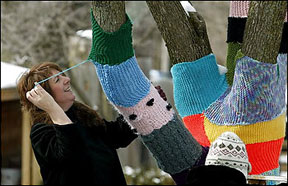 At the end of last week, two public art projects competed for media attention in the USA. In the small town of Yellow Springs, Ohio, a few local women knitted a sweater for ONE tree during a winter day. Any volunteer knitter could climb the eight-foot ladder and add her wrap to the tree trunk or limb. In Las Vegas, two of world’s largest resort and gaming corporations announced a $40 million dollar expenditure for fine art at the future CityCenter $8 billion casino and resort. New huge artworks have been commissioned from Jenny Holzer, Nancy Rubins, Maya Lin and Richard Long plus the display of large existing works by Oldenburg/ van Bruggen, Frank Stella and Henry Moore.
At the end of last week, two public art projects competed for media attention in the USA. In the small town of Yellow Springs, Ohio, a few local women knitted a sweater for ONE tree during a winter day. Any volunteer knitter could climb the eight-foot ladder and add her wrap to the tree trunk or limb. In Las Vegas, two of world’s largest resort and gaming corporations announced a $40 million dollar expenditure for fine art at the future CityCenter $8 billion casino and resort. New huge artworks have been commissioned from Jenny Holzer, Nancy Rubins, Maya Lin and Richard Long plus the display of large existing works by Oldenburg/ van Bruggen, Frank Stella and Henry Moore.
Here is the result of “Head to Head” public art media blitz.
Yellow Springs Knitters
·
Strategy: Someone must have known a local AP stringer. Stringer pitches story to AP. Report with picture hits the AP wire.·
Results: Multiple publications in daily newspapers across the United States including Washington Post, NY Times, Boston Globe, International Herald Tribune, etc, etc, etc.·
Economic Development: Yellow Springs spreads its reputation as an “artsy” community.MGM Mirage and Dubai World
·
Strategy: Write the article in the form of a press release and distribute via prnewswire.com. Call up editors and reports at various papers. Push hard.·
Results: One print article outside Nevada in the NY Times with online slide show that was picked up and republished in Taipei. Partial or full posting of prnewswire text on online business or gaming websites.·
Economic Development: Las Vegas has upscale resorts equivilent to Dubai.
Nancy Rubin Proposal for CityCenter
I am interested in why the Yellow Springs knitters out paced MGM Mirage. The greater success Yellow Springs comes from the actual installation of the artwork, not just a story about the future. Real people and their honest reactions could be interviewed on the streets near the tree. The NY Times had to stretch to find a few quotes and a very staged picture of Ms. Lin with a tiny segment of her silver river.
Yellow Springs had other advantages that public art programs might note. The artwork was colorful and clearly understood by a single photograph – strips of knit fabric tightly wrapping the trunk and limbs by local women as a celebration of winter and their own joyful spirit. The visual effect was dynamic on the tree.
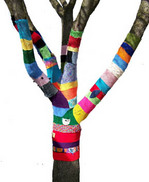 As reported by AP, Corrine Bayraktaroglu, an artist who helped start the “knitknot tree” project, stated: “People are really, really enjoying it. They’re coming from towns to have their photograph taken with the tree.”
As reported by AP, Corrine Bayraktaroglu, an artist who helped start the “knitknot tree” project, stated: “People are really, really enjoying it. They’re coming from towns to have their photograph taken with the tree.”
How many civic art programs strive for this reported comment on an abstract, design-integrated public artwork: “It looks like Yellow Springs; it’s unique, it’s colorful, unpredictable,” said Lynda Sirk. “It makes me smile. That’s what I like.” Unique, colorful, unpredictable – all words welcome in any critical commentary on Nancy Rubins, Frank Stella and Oldenburg/van Bruggen in Las Vegas.
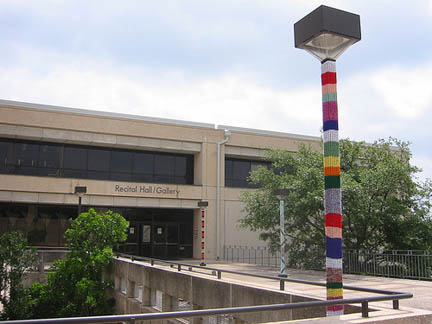
Houston’s Knitta wrapping light poles in San Antonio
I was surprised to learn that knitted artworks for the street are a practiced artform. A group of six artists from Houston called Knitta have been collectively wrapping elements of the street for the last three years. A knittaplease photo collection is available on Flickr.
Tree Cozies in Indiana (photos “The Republic”)
Also this winter is the tree cozy competition in Columbus, Indiana. 30 artists wrapped the lower trunk of 30 street trees with knitted works. Alice Dorwsky (spelling help?) of New England has been making beautiful yellow wraps and tree hangings for the last few years.
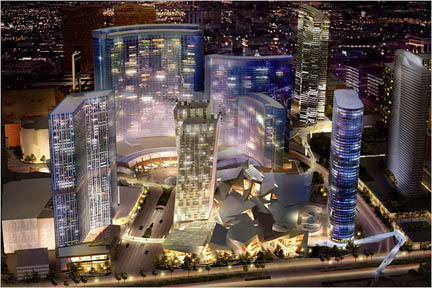
CityCenter Design (NY Times Slide Show)
Back to CityCenter in Las Vegas. What to make of the end of bad taste in Sin City? When Steve Wynn added art to his other casinos in the 1990s, the art was tasteful, but not the setting. With CityCenter line up of architects – Foster, Pelli, Vinoly and Libeskind – now the French and other European critics will stop commenting and Japanese youth will stop visiting. Viva Las Vegas might be approaching retirement. Even Las Vegas can become just another flashy resort. What could be worse?
For the record, $40 million is only one-half of a percent (1/2%) of the $8 billion project. So although it sounds and IS a lot of money for art, a typical 1% for art program would receive $80 million.
But still the world was more interested in the $50 dollars of yarn in Yellow Springs this weekend.
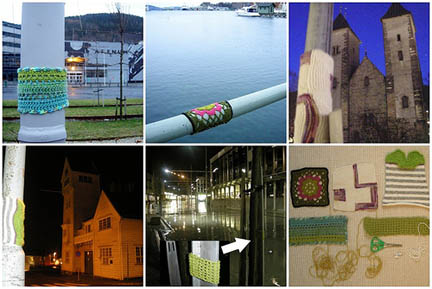

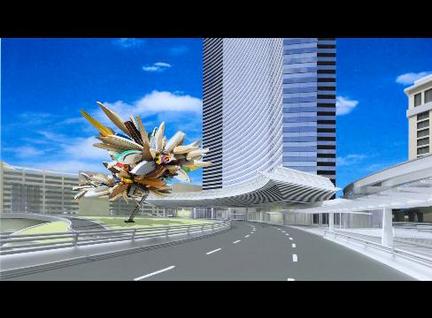
Reis Writes
I think you are reading too much into the disparity in press coverage.
One is a cute, human interest story. The majority of papers reprinting the Ohio knitting piece (and my rural paper did so) are entirely oblivious to the issues of public art, funding, access, class and critical theory you allude to.
Instead, they see wacky artists doing something amusing.
With a picture.
This kind of street art is not exactly “public art”, unless public art as a category includes graffiti, posters, busking and mime. Which is not to put it down in any way- I like it a lot. I went to a workshop the original Knitta’s put on here in Seattle a while ago, and I dug em.
The aspects of the feminist craft revival that I find interesting, that the Knittas and this Ohio group are commenting on, however, like the anti-consumerism angle, the feminisation and softening of mostly male designed public spaces, the demand to recognize the importance, both culturally and artistically of historically female crafts, none of these are even touched on in the “human interest” reporting on this piece.
Meanwhile, in Vegas, we have another yawn inducing example of developers using artists as high end decorators, to gain a bit of cultural cachet. None of these artists are being given any control over the space- these are all plop and drops of “culture”.
There may have been a time when Jenny Holzer was subversive- but her format and simulcrums of her messages have been co-opted decades ago by advertisers and commercial space designers. Maya Lin’s work at the Vietnam Memorial has a subtle power that is reinforced by the environment- but hanging above a reception desk, I somehow fail to be convinced it will change the way people think, or make them cry. Nancy Rubins, whose work I, personally, adore, will probably just mystify visitors who quickly gaze away.
So I am not surprised this didnt get much press. There is nothing new, nothing exciting, and nothing even scandalous or titalating about any of this work.
In fact, it brings up the old “how low will you go” conundrum. Right before he was deposed, the Shah of Iran was preparing to commission a bunch of artists to produce huge, expensive works in Tehran. There was a big buzz in the Artworld as to how moral it was to create work for a guy whose secret police tortured religious radicals to death. Some artists refused, others claimed their art was removed from his politics.
Similarly, how much money is enough to decorate a casino? Not to infer that Steve Wynn tortures anybody, at least, not physically.
By the way- love your new format- even if I seem to be incapable of satisfying Captcha.
Weiss Responds
I don’t think I am making to much from the difference. Public art is a public artform and we need to understand the vehicles to touch the public. Media is one method, so studying success and failure helps us understand. Another method is to learn from Gromley’s has amazing success in attracting the internet photographer.
I need to visit Denver to see the public winner amoung the giant pop creatures: the Blue Bear, The Silver Cow and Calf, the Horse on a Red Chair and Jimenez’s new Blue Stalion at the entry to the airport. How and why is pop working for contact with the public?
PS. Thanks to AJ Founder Doug McLellan for the new Design
From Jonny McKerr of Craigavon, Northern Ireland
This is really cool!
Note from the Artists in Yellow Springs.
We outstripped mgm, LOL! Oh my lord, you know, I am astounded our knit knot tree got so much press, who would have guessed. There was no feminist agenda or political or otherwise. We did it for fun, Nancy and I, just like many of the projects we do around Yellow Springs. We also as members of the local arts council try to come up with fun ways to promote the arts on a budget of err, let’s see, hum zero.
WE have the back story on the tree on our website (non commercial) http://www.jafagirlart.com
You will see that we were actually inspired by knitta last year when we started the project. They are an amazing group and certainly deserve major credit for taking knitting to a whole new level.
I’d have to disagree with Reis – I think it’s more than “wacky artists doing something amusing”. The amazing thing about the knitted public art is that it shows how a community-based public art project, where actual community members take part in the creation and where the installation is in a place where people live and work, is actually much more vital to communities than the expansion of a casino, even if it does include the expansion of world-class collections. When it comes down to it, when i’m walking to work in the morning and am able to participate in the creation of a tree-sweater (being a knitter myself), I am much more likely to feel engaged – than I am reading about a casino.
What bothers me about what Reis says is that there is still a clear line in the arts world between “community arts”, which in the way it’s described above make it sound as though it’s superfluous, and “high art”, which is clearly more important to communities.
Field, we’ve got to find a way to get past this.
I am sorry if I was unclear- I was not stating my opinion- I was stating what I think the opinion of the newspaper editors are, who are publishing this piece.
This is based on the newspaper editor around here, who I know pretty well.
I, personally, do not draw a line between community based arts, and “high” art. I think its all part of the same continuim, and equally valid and interesting. I do think there is a distinct category of publicly funded art, mainly for civic buildings, which has different rules, requirements, and end results, than temporary community based pieces, but I like both.
I like the knitted stuff quite a bit. And I am a craft based artist myself, and do not in any way disparage hand/eye skills.
I would like to also point out that, even before Knitta, many artists have been doing this kind of thing.
I like the work of Robyn Love, for example, which was recently pointed out to me by a friend-
http://robynlove.com/
She has been doing this sort of public, knitted interventions since the mid 90’s.
And also Freddie Robins, from the UK- check out her knitted wedding-
http://www.freddierobins.com/
http://www.castoff.info/wedding.asp
I have been knitting, myself, since the late 60’s, although I am more of a Crochet Man most of the time.
Beautiful handmade crochet clothing items.